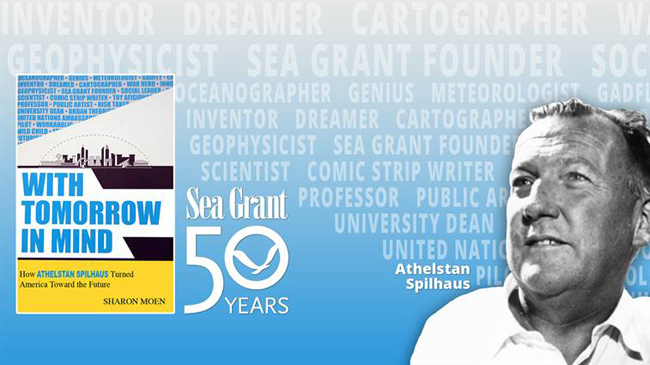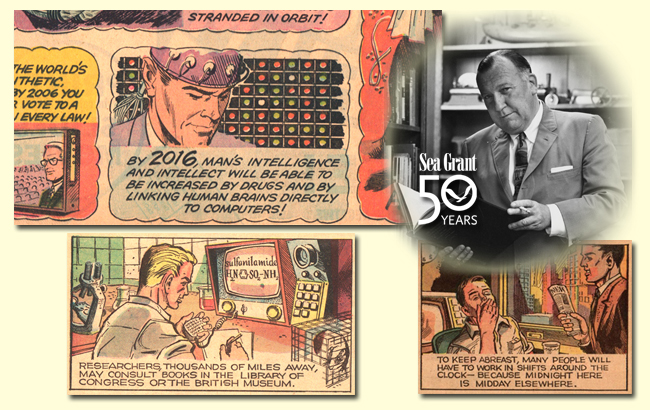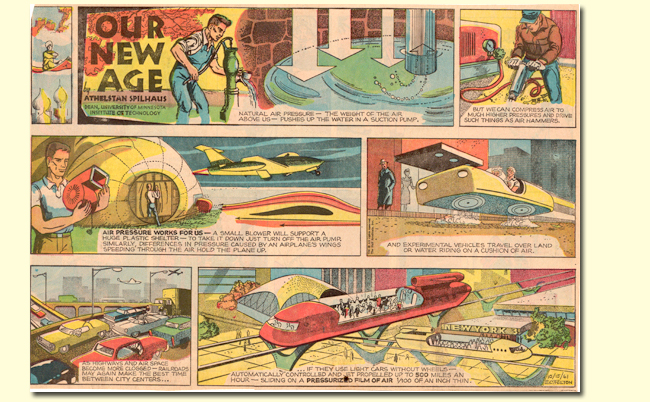|

|
|
#SeaGrant50: The Dazzling Dr. Spilhaus
By Paul F on Mar 11, 2016 at 10:14 AM
NOAA’s National Sea Grant Program was conceived in the back of a taxi speeding through Minneapolis in 1963
By Jennifer Kimball Gasperini, Minnesota Sea Grant

WASHINGTON, DC, Wednesday, March 02, 2016 - The National Oceanic and Atmospheric Administration's (NOAA) National Sea Grant College Program (NSGCP) was conceived in the back of a taxi speeding through Minneapolis in 1963. This backseat origin story is one of many startling and awe inspiring tales relayed throughout the pages of With Tomorrow in Mind: How Athelstan Spilhaus Turned America Toward the Future. In honor of the momentum that began that day in a Minnesota taxicab and in celebration of Sea Grant’s 50th anniversary, Minnesota Sea Grant is proud to present the biography of Dr. Athelstan Frederick Spilhaus.
Sharon Moen, science writer for Minnesota Sea Grant, spent years piecing together the vast and varied accomplishments of Dr. Spilhaus, a Renaissance man whose lifework involved oceanography, aeronautical engineering, public policy, public art, America’s space race, a syndicated comic strip, international relations and an extensive mechanical toy collection, among other pursuits.
“Walter Cronkite called Spilhaus the most interesting person he ever interviewed,” said Moen. “Others called him ‘genius,’ ‘gadfly,’ ‘the ocean community’s Michelangelo.’”
Born in South Africa, Spilhaus appeared at the admissions office of MIT and asked to be accepted into the graduate program without having applied. He was admitted on probation and earned a master’s of science degree in aeronautical engineering.
The book is a page-turner. Readers will be surprised to learn how Spilhaus’s invention of the bathythermograph during graduate school aided Allied troops during WWII to the point where Winston Churchill wrote Spilhaus a personal thank you note. Maybe even more dumbfounding is Spilhaus’s part in creating UFO hysteria. As stated in The Economist (1998), “It would be unfair to blame Athelstan Spilhaus for what came to be called the Roswell Incident. All the same, ....”
Outraged by the surprise launch of Sputnik, Spilhaus authored a syndicated comic strip called Our New Age that ran weekly for 15 years, reaching 5 million readers in 19 countries. This was only one of his efforts to improve the average American’s knowledge of science. When Dr. Spilhaus met President Kennedy in 1962, JFK told him, “The only science I ever learned was from your comic strip in the Boston Globe.”

Spilly, as he was known by friends, was a character; he spoke off-the-cuff and liked a good time. Yet, he served as the dean of the Institute of Technology at the University of Minnesota, a superintendent of a school district in Florida and as one of NOAA’s first advisors. He conceptualized the Minneapolis skyway system and the Triangle of the Sun installation that still graces the entrance of the McGraw-Hill Building in New York City (pictured above).
Concerned about over-population and the troubling tide of people vacating cities for suburbs, Spilhaus collaborated with Buckminster Fuller on the planning of an experimental city that would have been one mighty research laboratory. Designed with complete material and water recycling and no internal combustion engines, the city, which was close to being built, was to thrive on a constant flow of research and technological development.
As the NOAA Sea Grant Program continues to demonstrate, Spilhaus’s legacy is one of creative problem-solving. “I’m impatient with the past and irritable with the present,” he said. “The future is where my concern lies, and I’m very optimistic about it.”
For more information on With Tomorrow in Mind: How Athelstan Spilhaus Turned America Toward the Future, please visit Minnesota Sea Grant.


Athelstan Spilhaus wrote “Our New Age” from its inception in 1957 until 1973, although the comic strip went through three different illustrators: first Earl Cros, then E.C. Felton, then Gene Fawcette. “Our New Age” had an enormous audience almost immediately. A 1959 article in Time magazine noted that the strip appeared in 102 U.S. and 19 foreign newspapers.
Pictured above are three different entries in the Sunday comic strip series: (Top Row) From the December 26, 1965 edition; (Middle Row); Two entries from 1962, including Connecting to Libraries of the Future," as imagined in the February 19, 1962 edition; (Bottom Row) The October 14, 1961 edition of "Our New Age." Photos: Courtesy of The Smithsonian magazine.
During Sea Grant's 50th Anniversary, The NSGCP will gather and share related content
from the individual 33 Sea Grant programs on social media via its social media channels using the hashtag #SeaGrant50:
---
On www.nyseagrant.org ...
- Our "Trending Topics," such as climate change and green tips for coastal living, via a section on our homepage, www.nyseagrant.org.
- For the latest news from NYSG, check out our 'Currents' section, www.nyseagrant.org/currents, as well as our 'by-topic' archives, www.nyseagrant.org/currentsarchive.
- To keep tabs on all of NYSG's coastal science news, follow us on Facebook (www.facebook.com/nyseagrant), Twitter (www.twitter.com/nyseagrant) and YouTube (www.youtube.com/nyseagrant); Subscribe to our free news feeds (click the orange & white icon in the "Follow Us" navigation bar at www.nyseagrant.org); Sign up for our e-list in a few quick clicks at www.nyseagrant.org/nycoastlines. Our flagship publication, NY Coastlines / Currents, is published 1-2 times a year.
|
© New York Sea Grant 2023. All Rights Reserved.
Website Design by Gatorworks
|
|